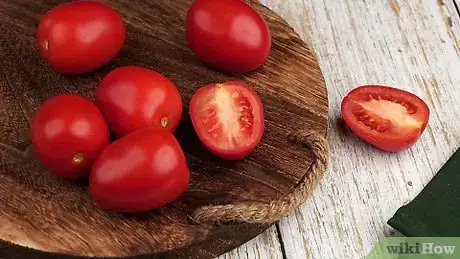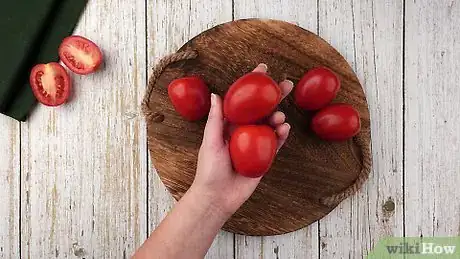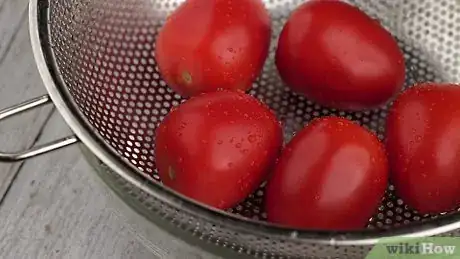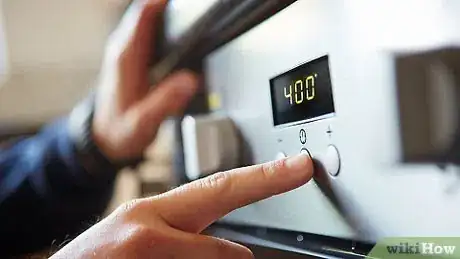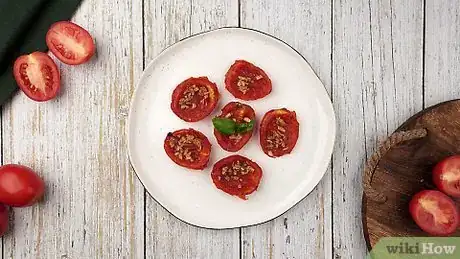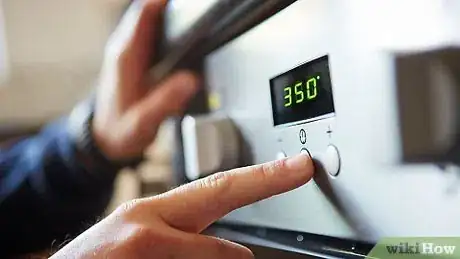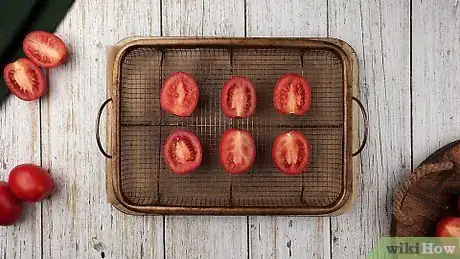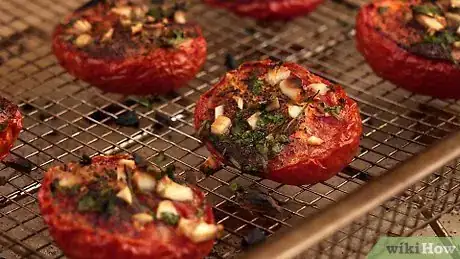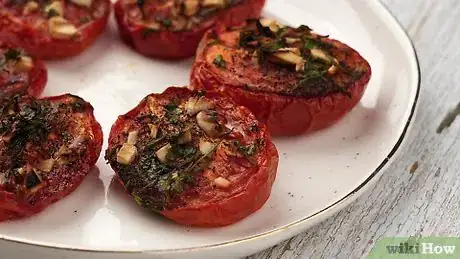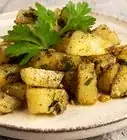This article was co-authored by Tara Coleman. Tara Coleman is a Clinical Nutritionist who has a private practice in San Diego, California. With over 15 years of experience, Tara specializes in sports nutrition, body confidence, and immune system health and offers personalized nutrition, corporate wellness, and online learning courses. She received a BS in Biology from James Madison University and spent six years in the pharmaceutical industry as an analytical chemist before founding her practice. Tara has been featured on NBC, CBS, Fox, ESPN, and Dr. Oz The Good Life as well as in Forbes, Cosmopolitan, Self, and Runner’s World.
There are 19 references cited in this article, which can be found at the bottom of the page.
This article has been viewed 61,163 times.
There are various ways to roast tomatoes to make them delicious and slightly caramelized. The simplest way to cook the tomatoes is in oil at a high temperature for a short amount of time. If you wish to avoid oil, roast your tomatoes quickly in balsamic vinegar. To get more concentrated flavors, slow roast the tomatoes at a low temperature for a few hours. Roasted tomatoes make for a great snack but also pair well with various dishes, from seafood to pasta with tomato sauce.
Ingredients
- 6 large plum tomatoes
- ¾ teaspoon (4.27 g) of salt
- ½ teaspoon (1.15 g) of black pepper
- 2 tablespoons (30 mL) of olive oil
Makes 6 servings
- 5 large plum tomatoes
- 1 1⁄2 tablespoons (22 mL) of a balsamic vinegar
- 2 teaspoons (8.00 g) of sugar
- 1 teaspoon (5.69 g) of salt
- 1 teaspoon (2.3 g) of black pepper.
- 2 tablespoons (3.20 g) of chopped parsley
- 2 tablespoons (3.20 g) of chopped basil
Makes 4 servings
- 4 lb (1.8 kg) of plum tomatoes
- 5 tablespoons (74 mL) of olive oil
- 1 teaspoon (5.69 g) of salt
- 1 teaspoon (2.30 g) of black pepper
- 6 cloves of garlic, minced
Makes 5 servings
Steps
Selecting and Cleaning Tomatoes
-
1Choose smaller tomatoes for quicker, faster roasting. Cherry tomatoes and grape tomatoes are often used for roasting. These tomatoes cook quickly and are much easier to handle than larger tomatoes. Grape tomatoes are meatier and not as sweet as cherry tomatoes.[1]
- Smaller tomatoes are often cut into halves, but they can also be roasted whole.[2]
-
2Use larger tomatoes if you need ones that hold their shape better. Plum tomatoes are commonly used in roasting, although any type of tomato works. Look for Roma tomatoes, which are a tangy type of plum tomato with few seeds. They hold up well in heat, making them a great snack or ingredient in another recipe.[3]
- Some large tomatoes are roasted after being cut in half. To maximize your yield, divide each tomato up into slices.
Advertisement -
3Wash the tomatoes under running water and brush off dirt. Hold them under cold water for about 20 seconds. As you wash the tomatoes, lightly rub the tomatoes with your fingers to knock off stubborn dirt particles. Avoid using scrub brushes, since most tomatoes are too delicate to withstand them.[4]
- Load smaller tomatoes in a colander to wash them more easily.
- You do not need to use soap or any other products to wash the tomatoes.
-
4Cut the tomatoes in half or in slices. Lay the tomatoes on a cutting board, then use a paring knife to split them. For smaller tomatoes, cut them lengthwise to form 2 halves that will lay flat on a baking sheet. Cut larger tomatoes horizontally to form a top and bottom half.[5]
- For big tomatoes, slice the halves again horizontally. Divide them up into rings about 3⁄4 in (1.9 cm) thick. You will get 3 or 4 slices from most tomatoes.
- To avoid extra prep work, leave small tomatoes whole. Whole tomatoes are perfect if you plan on dicing them in a food processor later. They will burst when they’re done cooking.
-
5Remove the stem and seeds from the tomatoes. Use a paring knife to cut the stem off the top piece of the tomato if it is still present. Then, arrange the tomatoes with the cut side facing up. Scoop out the fleshy parts with the seeds, leaving the meat of the tomatoes intact.[6]
- To remove seeds from smaller tomatoes, try gently squeezing them.
Cooking Tomatoes in Oil
-
1Preheat the oven to 400 °F (204 °C). Let the oven warm up for about 15 minutes. Roasting the tomatoes at a high temperature cooks them through relatively quickly. If you need to extend the cooking time, lower the heat setting.[7]
- The cooking time will change depending on your oven and what temperature setting you use.
-
2Pour the olive oil and seasonings into a roasting dish. Add about 2 tablespoons (30 mL) of olive oil to the dish. Mix in about ¾ teaspoon (4.27 g) of salt and ½ teaspoon (1.15 g) of black pepper. Then, chop up garlic and any additional herbs you wish to add and stir them into the oil.[8]
- For example, you could slice up about 4 cloves of garlic along with ½ a bunch of fresh thyme and rosemary.
-
3Place the tomatoes cut side down after mixing them into the oil. Mix all of the tomatoes in the oil until they’re well-coated. Make sure they’re seasoned to your liking before you move them into the oven. If you mixed the tomatoes in a roasting pan, arrange them so they’re in a single layer.[9]
- Another way to coat the tomatoes is to toss them in a mixing bowl with the oil. Move them to a baking tray or dish afterwards.
-
4Roast the tomatoes for at least 15 to 20 minutes. Wait for the tomatoes to soften and begin to wrinkle. Check the edges to make sure they have begun to brown. The tomatoes will still be juicy, so continue cooking them as needed before serving them.[10]
- The cooking time will vary depending on the size of the tomatoes. Large slices of Roma tomatoes require about 10 to 20 more minutes of cooking than grape or cherry tomatoes, for instance.
- Store any tomatoes you don’t use in the refrigerator for up to 5 days or in the freezer for up to 6 months.
Baking Tomatoes with Balsamic Vinegar
-
1Preheat the oven to 350 °F (177 °C). Preheating the oven takes 10 to 15 minutes. At a high temperature like this, tomatoes roast in half an hour or less. Reduce the temperature if you prefer a longer cooking time to lock more flavor in the tomatoes, reduce the temperature to about 275 °F (135 °C) and plan on cooking them for up to 2 hours.[11]
- Your cooking time may vary depending on your oven and the settings you use.
-
2Place the tomatoes on baking sheets lined with parchment paper. Since this recipe doesn’t use oil, you need the parchment paper to prevent the tomatoes from sticking and burning. Arrange the tomatoes in a single layer on the sheets. For larger batches of tomatoes, you will need multiple sheets.[12]
-
3Mix balsamic vinegar with herbs and spices. For a basic vinegar mixture, pour about 1 1⁄2 tablespoons (22 mL) of a quality balsamic vinegar into a separate bowl. Mince up 2 large cloves of garlic and add them in. Also mix in 2 teaspoons (8.0- g) of sugar, 1 teaspoon (5.69 g) of salt, and 1 teaspoon (2.3 g) of black pepper. Finish the mixture with about 2 tablespoons (3.20 g) of chopped parsley and basil.[13]
- For an easy way to season the tomatoes, try using your favorite balsamic vinaigrette. Be aware of the ingredients, since vinaigrettes already contain oil, sugar, salt, and pepper.[14]
- Customize the vinegar mix to your liking. For example, try using less black pepper or sprinkling the tomatoes with grated Parmesan cheese after basting them.
-
4Baste the tomatoes with the mixture. If you have a basting brush, use it to spread the balsamic seasoning around. Otherwise, scoop up some of the mixture with a spoon. Slowly drizzle the balsamic over the tomatoes, coating them all as evenly as possible.[15]
- Use a small spoon to avoid adding too much of the mixture to each tomato.
-
5Cook the tomatoes for up to 30 minutes. Begin checking the tomatoes after 15 minutes. Wait for the tomatoes to soften. The finished tomatoes will look darker and a little browned. Serve them while they’re hot.[16]
- If you notice the tomatoes splitting apart, get them out of the oven right away to prevent them from overcooking.
- Store leftover tomatoes in the refrigerator for up to 5 days or in the freezer for up to 6 months.
Roasting Tomatoes Slowly
-
1Preheat the oven to 225 °F (107 °C). Heat the oven for about 10 minutes before putting the tomatoes in. The key to slow-roasted tomatoes is a low cooking temperature. That way, they don’t burn despite being exposed to heat over a long period of time.[17]
- Slow-roasting removes more moisture from the tomatoes, leading to more intense flavors.
-
2Place the tomatoes on a clean metal baking rack over a baking sheet. Fit the baking rack over a baking tray or a dish of a similar size. Spread the tomatoes out in a single layer across the rack, keeping the cut sides face up. The tray helps drain the tomatoes so they dry out more efficiently.[18]
- If you don’t have a baking rack, line the sheet with parchment paper or put the tomatoes directly on the sheet. Any juice in the pan will steam the tomatoes, so make sure they’re well-cleaned before putting them in the oven.[19]
-
3Drizzle olive oil over the tomatoes. Coat the tomatoes with about 5 tablespoons (74 mL) of oil. If you have a basting brush, brush the tomatoes with generous amounts of the oil. Otherwise, use a spoon to pour the oil onto the tomatoes.[20]
- Adjust the amount of olive oil you use according to how many tomatoes you plan on roasting.
-
4Season the tomatoes with salt, pepper, and herbs. For a simple seasoning, sprinkle the tomatoes with salt and pepper to taste. You only need a light amount of draw out the flavor, such as a 1 teaspoon (5.69 g) of salt and 1 teaspoon (2.30 g) of black pepper or less. Add additional seasonings according to how you want the tomatoes to taste.[21]
- For example, mince about 6 cloves of garlic and sprinkle them over the tomatoes. Also, try chopping up about ½ cup (14.37 g) of thyme, rosemary, or other herbs. All of these extras are optional, as the critical part is the oil and salt.
- Sprinkle on about 1 tablespoon (12.50 g) of sugar to reduce the acidity from the tomatoes if desired.[22] You can also use a little baking powder to cut the acid.
-
5Roast the tomatoes for 4 to 6 hours. The tomatoes will retain their shape despite shrinking and looking wrinkled. Make sure the tomatoes have a dark red color and look a little browned around the edges.[23]
- To increase their flavor, roast the tomatoes for longer. They can be safely left in the oven for up to 8 hours.
-
6Cool the tomatoes before using or storing them. Take the baking sheet out of the oven. The tomatoes will cool much more quickly if you have a rack in place. Eat the tomatoes as-is or add them to a recipe.[24]
- Store leftovers in sealed jars or containers. They will last about 5 days in the refrigerator and 6 months in the freezer.
Community Q&A
-
QuestionCan these roasted tomatoes be frozen?
 Riley NextCommunity AnswerYes, you can roast a tomato and then freeze it. However, they can easily succumb to freezer burn. Store them in an airtight container.
Riley NextCommunity AnswerYes, you can roast a tomato and then freeze it. However, they can easily succumb to freezer burn. Store them in an airtight container.
Warnings
- Tomato juice is acidic and breaks down aluminum. To prevent the metal from leaching into the tomatoes, avoid using aluminum or uncoated baking or roasting dishes. Stick to ceramic and glass or use parchment paper.⧼thumbs_response⧽
Things You'll Need
Selecting and Cleaning Tomatoes
- Cutting board
- Paring knife
- Spoon
Cooking Tomatoes in Oil
- Roasting dish
- Measuring cup
- Mixing spoon or bowl
- Oven mitts
- Cutting board
- Knife
Baking Tomatoes with Balsamic Vinegar
- Baking sheet
- Parchment paper
- Measuring cup
- Basting brush
- Oven mitts
- Cutting board
- Knife
Roasting Tomatoes Slowly
- Metal baking rack
- Baking sheet
- Basting brush
- Measuring cup
- Oven mitts
- Cutting board
- Knife
References
- ↑ https://www.allrecipes.com/recipe/186746/roasted-tomatoes-with-garlic/
- ↑ https://www.bonappetit.com/recipe/roasted-cherry-tomatoes
- ↑ https://www.epicurious.com/recipes/food/views/roasted-tomatoes-235766
- ↑ https://www.fda.gov/ForConsumers/ConsumerUpdates/ucm256215.htm
- ↑ https://www.allrecipes.com/recipe/206583/roasted-roma-tomatoes/
- ↑ https://foodsafety.wisc.edu/assets/pdf_Files/safe_handling_tomatoes.pdf
- ↑ https://www.foodnetwork.com/recipes/ina-garten/roasted-tomatoes-recipe-1947520
- ↑ https://www.epicurious.com/recipes/food/views/roasted-tomatoes-235766
- ↑ https://thecozyapron.com/roasted-tomatoes/
- ↑ https://www.allrecipes.com/recipe/186746/roasted-tomatoes-with-garlic/
- ↑ https://easyhealthllc.com/diabetes/balsamic-roasted-cherry-tomatoes/
- ↑ https://oneshetwoshe.com/balsamic-roasted-tomatoes/
- ↑ https://www.fivehearthome.com/balsamic-roasted-tomatoes/
- ↑ https://www.foodnetwork.com/recipes/sandra-lee/balsamic-roasted-tomatoes-recipe-1937454
- ↑ https://www.fivehearthome.com/balsamic-roasted-tomatoes/
- ↑ https://www.foodnetwork.com/recipes/sandra-lee/balsamic-roasted-tomatoes-recipe-1937454
- ↑ https://www.carolinescooking.com/slow-roasted-tomatoes/
- ↑ https://www.houseandgarden.co.uk/recipe/homemade-slow-roasted-tomatoes
- ↑ https://www.youtube.com/watch?v=Twx-zbFDlFo&feature=youtu.be&t=109
- ↑ https://www.epicurious.com/recipes/food/views/slow-roasted-tomatoes-102278
- ↑ https://pinchandswirl.com/slow-roasted-tomatoes-olive-oil-thyme/
- ↑ https://www.myrecipes.com/recipe/aromatic-slow-roasted-tomatoes
- ↑ https://www.youtube.com/watch?v=Twx-zbFDlFo&feature=youtu.be&t=123
- ↑ https://www.epicurious.com/recipes/food/views/slow-roasted-tomatoes-102278
About This Article
To roast tomatoes in the oven, start by cutting them in half or into slices and removing the stems and seeds. Then, spread the tomatoes out on a baking sheet lined with parchment paper. Next, mix balsamic vinegar with some herbs and spices, and brush the mixture onto the tomatoes. Finally, roast the tomatoes in the oven for 15-30 minutes at 350 degrees Fahrenheit. To learn how to roast tomatoes on the stovetop, read on!
